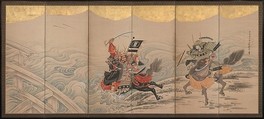Returned to lender The Met accepts temporary loans of art both for short-term exhibitions and for long-term display in its galleries.
Race at the Uji River
Soga Shōhaku Japanese
Not on view
This screen depicts a scene from the fourteenth-century military narrative The Tale of the Heike (Heike monogatari), the most important of the early medieval Japanese battle epics, in which the valiant warriors Kajiwara Genta Kagesue and Sasaki Shirō Takatsuna race to cross the Uji River and be the first to engage the enemy on the far bank. The rebel soldiers have stripped the bridge to its frame, leaving no way to cross the river except by fording its violent current. At the center, clearly in the lead and already cutting incoming arrows out of the air with his sword, Kagesue is riding the fierce black horse Surusumi. His rival Takatsuna, our hero, in seemingly heavy white make-up, is close behind and mounted on the chestnut horse Ikezuki. As a ploy, Takatsuna points to Kagesue’s saddle girth, shouting a warning that it is loose and convincing him to stop and tighten it. Distracted, Kagesue pulls back, allowing Takatsuna to race ahead and achieve the glory of being first to the other side.
The work is signed “Soga Sakonjirō Kiyū Jasokuken Shōhaku hitsu,” and it bears the round relief seal “Shōhaku,” the square relief seal “Joki,” the small square intaglio seal “Soga Kiyū,” and the small square relief seal “Soga.”
Due to rights restrictions, this image cannot be enlarged, viewed at full screen, or downloaded.
This artwork is meant to be viewed from right to left. Scroll left to view more.



